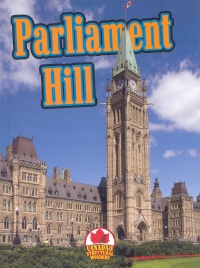| ________________
CM . . . . Volume XIX Number 20 . . . . January 25, 2013
excerpt:
Parliament Hill, by Simon Rose, is one book in the series "Canada's Structural Wonders". The other two are about the CN Tower and Confederation Bridge. Each aims to present the science, history and key people behind these structures. Rose describes the construction of the East, West and Centre Blocks of Canada's Parliament, situated on 184,156 square meters of land in downtown Ottawa overlooking the Ottawa River. Rose is strong on numerical facts. Did you know that the height of the Peace Tower is 92.2 meters? Rose provides a good introduction to the "symbolic heart of the country". His construction timeline starts in 1858, when Ottawa, then Bytown, was selected as Canada's national capital, and it ends when Parliament Hill and the Parliament Buildings were designated as a National Historic Site. Included in the 24 pages is a glossary of terms like "gargoyles", "mortar" and "quarry". The layout is like that of a web page or a magazine - plentiful photographs with short paragraphs of text. The writing style is compressed, probably because the author was required to convey as much information as possible as briefly as possible. In the section about "Parliament Hill's Builders", 19th century architects Thomas Fuller, Chilion Jones, Thomas Stent and Augustus Lever are mentioned specifically, and the contributions of quarry workers, masons and labourers are discussed generally. The author missed an opportunity, however, to mention the Parliamentary sculptors, particularly the first woman in that position, Eleanor Milne, who was appointed in 1962. She is famous for her 16 panel frieze depicting Canadian history. The tiny ornate Library of Parliament, the only part of the original Centre Block to survive the 1916 fire, is mentioned on Page 13, but the photo does not do it justice. In mentioning statues, the author names six in particular, but instead of including photos of those to which he refers, he chose a picture of Thomas Darcy McGee's statue. Having done so, Rose could have mentioned McGee's assassination for his political views. The buildings on Parliament Hill were constructed in an era when architecture and the skilled trades were closed to women; consequently, men predominate in Rose's account. He could have reached out to girls, though, by mentioning the "Famous Five" sculpture on Parliament Hill. It commemorates the "Persons Case", the victory of five Canadian women in having women recognized under the law as "persons", with full rights as Canadian citizens. This statue, by Edmontonian Barbara Paterson, depicts the five women larger than life, in a circle, delighted to have been interrupted at tea by news of the 1929 Privy Council ruling which made them "persons". Visitors to Parliament Hill like to have their pictures taken hugging these women or sitting on their laps. The author provides three Government of Canada websites for further research, one on the history of Parliament Hill, one on visiting the Hill, and one on the 1916 Centre Block fire. On Page 15, the words "Virtual Tour" appear above some information on the number of stone blocks in the Centre Block walls, but no website is given to take readers on the virtual tour. An expanded edition of Parliament Hill could provide more expansive writing and larger pictures. Recommended. Ruth Latta lives in Ottawa, ON, and loves Parliament Hill. Visit http://ruthlattabooks.blogspot.com for further information about her books.
To comment
on this title or this review, send mail to cm@umanitoba.ca.
Copyright © the Manitoba Library Association. Reproduction for personal
use is permitted only if this copyright notice is maintained. Any
other reproduction is prohibited without permission.
NEXT REVIEW |
TABLE OF CONTENTS FOR THIS ISSUE
- January 25, 2013.
AUTHORS |
TITLES |
MEDIA REVIEWS |
PROFILES |
BACK ISSUES |
SEARCH |
CMARCHIVE |
HOME |
